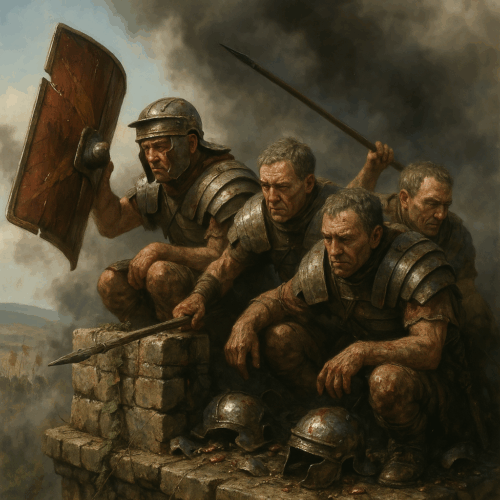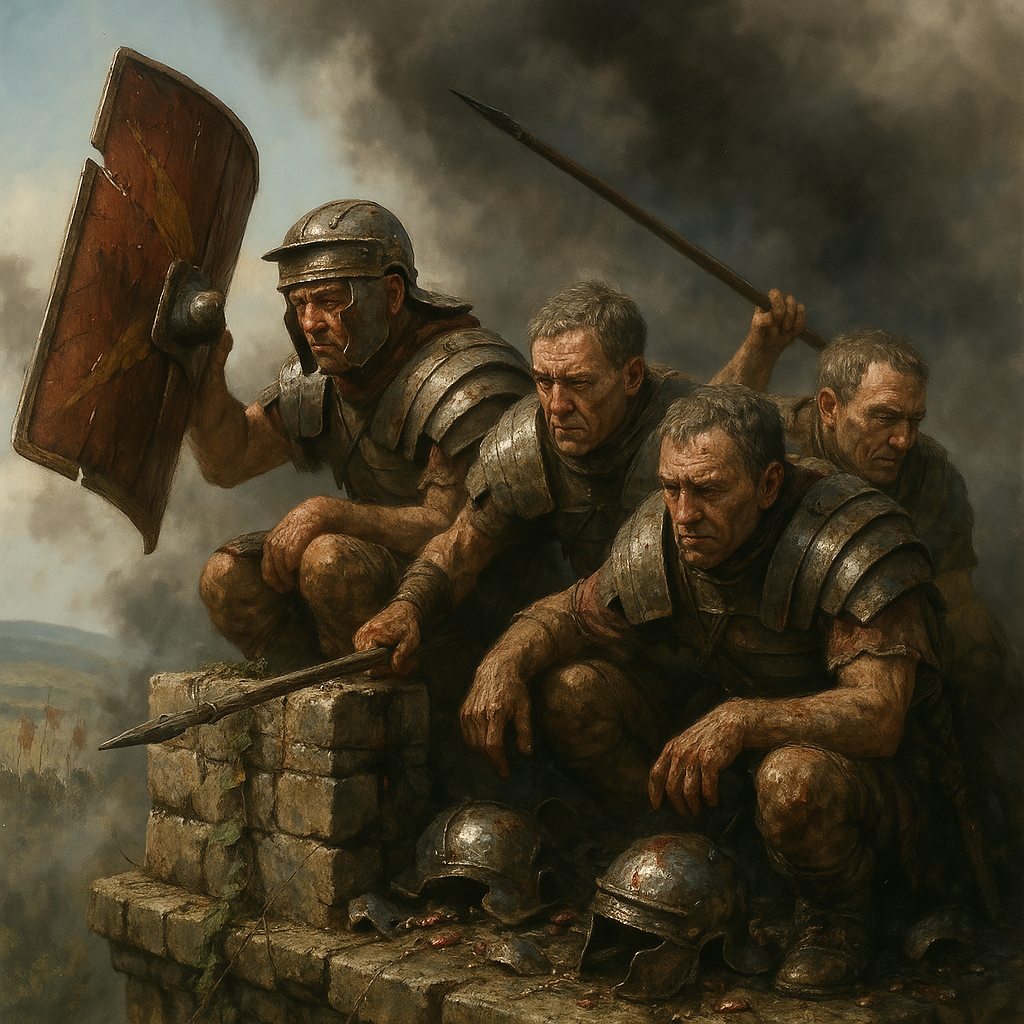On July 10, 48 BC, the rolling hills and rocky shores of Dyrrachium (modern Durrës, Albania) witnessed one of the most dramatic turning points in Julius Caesar’s civil war against Pompey the Great. Cornered, outnumbered, and facing the prospect of total annihilation, Caesar orchestrated a bold retreat that not only preserved his forces but also showcased the timeless principles of adaptability, courage, and strategic vision. More than two millennia later, the lessons from Dyrrachium continue to resonate with anyone striving to triumph over personal or professional crises.
In this deep dive, we’ll journey through the genesis of the conflict, trace the fierce struggle at Dyrrhachium, and extract practical insights you can apply to your own life. By the end, you’ll have a concrete plan—complete with specific bullet points and timelines—to channel your inner Caesar and turn looming setbacks into powerful comebacks.
- Rome on the Brink: Prelude to July 10, 48 BC
The Roman Republic in 49 BC was a tinderbox. Years of tension between Gaius Julius Caesar and the conservative senatorial faction led by Gnaeus Pompeius Magnus (Pompey) had exploded into open civil war. After crossing the Rubicon in January of 49 BC—an act of defiance immortalized by the phrase alea iacta est (“the die is cast”)—Caesar moved swiftly through Italy, Spain, and Greece, rallying legions to his camp.
By mid-48 BC, Caesar’s forces had secured victories at Pharsalus and Laodicea in Asia Minor, but Pompey commanded a numerically superior army and controlled the vital Adriatic coast. Recognizing the strategic importance of Dyrrachium’s harbor and its position as a gateway between Italy and the eastern provinces, Pompey fortified the town with an encircling line of camps stretching over 26 kilometers, effectively besieging Caesar’s advance.
Key factors setting the stage:
- Geography: Dyrrachium’s natural harbor allowed Pompey unrivaled naval support.
- Numbers: Pompey’s army likely exceeded 40,000 troops, reinforcing his outer fortifications with seasoned legions.
- Logistics: Caesar’s supply lines were vulnerable; cut them off and his legions would starve or surrender.
Amid this pressure, Caesar faced a choice: risk a frontal assault against impregnable works or outmaneuver Pompey despite overwhelming odds.
- The Siege and the Siegeworks
Rather than storm Dyrrachium, Caesar adopted a bold approach: build his own network of defenses to contain Pompey’s camps. His engineers dug trenches, erected ramparts, and installed towers—all under enemy archers’ fire. For nearly three weeks, the Roman camps lay face-to-face, each general sizing up the other’s resolve.
Highlights of Caesar’s engineering feat:
- Parallel Lines: Two concentric lines of fortifications—one facing Pompey’s camp, the other guarding Caesar’s rear—created a deadly pincer.
- Night Operations: Under cover of darkness, Caesar’s troops advanced earthworks, unobserved, often enduring artillery fire to plug gaps in the lines.
- Supply Raids: Small detachments slipped through Pompey’s watchers, raiding supply convoys and dragging provisions back behind the walls.
Despite these efforts, Pompey’s naval screen harassed Caesar’s foragers, and disease began to sap morale. Realizing that a prolonged standoff favored his opponent, Caesar prepared for a decisive action.
 III. July 10 Unfolds: The Battle’s Tipping Point
III. July 10 Unfolds: The Battle’s Tipping Point
On the morning of July 10, Caesar launched a surprise attack on a critical section of Pompey’s line near the Blusian Hill. His goal: breach the works, sever Pompey’s camp from sea access, and force a crisis.
Battle chronology:
- First Light Skirmishes: Light troops clashed along the hill’s base. Caesar’s scouts reported a weakly held segment.
- Rapid Infantry Charge: The Tenth Legion stormed the earthworks, overrunning the palisades before Pompey’s legate could rally reinforcements.
- Cavalry Counter-Charge: Pompey’s mounted units swept in, isolating Caesar’s forward cohorts.
- Caesar’s Personal Intervention: Seeing his men in peril, Caesar personally rode to the front, brandishing his sword and exhorting the soldiers to stand firm.
- Orderly Withdrawal: Outnumbered and risk of encirclement imminent, Caesar ordered a disciplined retreat behind his rear fortifications.
Though Caesar’s troops managed to preserve their standards, the day ended with heavy losses—perhaps a third of his legionaries killed or wounded. Victory belonged to Pompey in tactical terms, but the seed of Caesar’s legend lay in what followed: the masterful withdrawal that prevented total collapse.
- The Art of the Retreat: Turning Defeat into Opportunity
Retreat is often seen as cowardice, yet at Dyrrhachium, withdrawal became an instrument of strategy. Caesar’s orderly evacuation under fire showcased several timeless principles:
- Maintained Cohesion: Despite panic around them, Caesar’s legions moved in disciplined columns, shields interlocked, protecting the rear guard until the last man walked past the ramparts.
- Controlled Risk: Caesar left small rearguard detachments at key redoubts, delaying Pompey’s advance long enough for the main army to escape.
- Moral Leadership: Caesar’s visible presence on the battlefield—riding between cohorts, calming fears—bolstered morale and prevented rout.
- Adaptive Planning: Rather than cling to the siege, Caesar broke it off on his own terms, preserving the strategic initiative.
In military theory, the Dyrrachium withdrawal became a case study in turning tactical defeat into strategic advantage. Two weeks later, Caesar reemerged in Apollonia, replenished his ranks, and marched south to a decisive victory at Pharsalus on August 9, 48 BC.
 Aftermath and Historical Impact
Aftermath and Historical Impact
Though overshadowed by Pharsalus, the Battle of Dyrrhachium profoundly influenced Rome’s destiny:
- Check on Pompeian Overconfidence: Pompey’s tactical win did not translate into strategic dominance. His hesitation to pursue Caesar aggressively allowed the republic’s future dictator to regroup.
- Elevated Caesar’s Reputation: Surviving near-total annihilation underlined Caesar’s personal magnetism and tactical acumen among his legions.
- Shift in Civil War Momentum: The failure to annihilate Caesar at Dyrrachium prolonged the civil war, ultimately fracturing Republican institutions and ushering in imperial rule.
- Lessons for Generations: Chroniclers such as Plutarch emphasized the retreat as much as the siege, cementing it in military schoolbooks for centuries thereafter.
By reframing a tactical setback into a strategic opening, Caesar rewrote the narrative. His troops didn’t just survive—they grew in loyalty and confidence, convinced that their general could guide them through any crisis.
- Timeless Lessons from Dyrrachium
What can a modern individual—far removed from ancient battlefields—learn from a two-millennia-old retreat?
- Embrace Tactical Flexibility
- Recognize when a plan falters and have the courage to change course.
- Preserve core assets (people, finances, reputation) rather than fight losing battles.
- Lead from the Front
- Visibility matters. Face your team’s challenges alongside them.
- Personal example inspires confidence more than distant directives.
- Plan Your Exit Strategy
- Before launching major initiatives, map out contingency routes.
- Ensure backup resources are in place to salvage progress under pressure.
- Maintain Cohesion Under Stress
- Cultivate strong bonds within your team or support network.
- Establish clear communication channels to prevent panic.
- Deploy Small Wins to Regain Momentum
- Target manageable objectives that rebuild morale and capability.
- Reinforce belief in your overall vision by celebrating incremental successes.
VII. Applying Ancient Resilience to Your Life Today
Imagine you’re leading a startup that’s run out of cash, or you’re navigating a career crisis after a major setback. By channeling Caesar’s Dyrrhachium playbook, you can engineer a strategic retreat that sets the stage for a comeback.
Here’s how to translate those timeless principles into actionable steps:
- Identify the ‘Enemy Lines’ in Your Situation
- Map out what’s blocking progress (financial shortfall, market rejection, stalled negotiations).
- Assess whether direct confrontation (more investment, aggressive marketing) will truly break the deadlock.
- Fortify Your Base
- Secure your “rear camp”: emergency funds, supportive mentors, legal protections.
- Create quick-win projects (side services, consulting gigs) to inject cashflow.
- Execute a Disciplined Withdrawal
- Prioritize preserving your core team, key assets, and existing reputation.
- Communicate transparently with stakeholders: “Here’s why we’re pivoting.”
- Deploy a Small-Scale Counter-Sortie
- Test a new product feature or service with a niche customer segment.
- Use the feedback and revenue to rebuild confidence and resources.
- Rebuild and Reengage
- Once stabilized, plan your next major push with lessons learned.
- Acknowledge the retreat as a moment of strategic recalibration, not failure.
 VIII. A Practical 30-Day Comeback Blueprint
VIII. A Practical 30-Day Comeback Blueprint
To make these lessons stick, here’s a day-by-day plan inspired by Caesar’s resilience:
Week 1: Assessment & Fortification
- Day 1–2: List all major challenges and categorize by impact.
- Day 3–4: Audit resources—financial, human, reputational.
- Day 5–7: Establish emergency measures (bridging loans, freelance contracts, partner alliances).
Week 2: Controlled Withdrawal & Communication
- Day 8–9: Draft a clear narrative for stakeholders: what’s changing and why.
- Day 10: Conduct honest meetings with your team to explain the pivot.
- Day 11–14: Wind down unviable projects, reassign key talent to priority tasks.
Week 3: Small-Scale Counter-Attack
- Day 15: Identify a niche project likely to yield rapid feedback.
- Day 16–18: Build an MVP (minimum viable product) or service outline.
- Day 19–21: Launch pilot to a controlled audience, collect data.
Week 4: Reinforce & Relaunch
- Day 22–23: Analyze pilot results, celebrate small wins with your team.
- Day 24–26: Adjust your offering, refine messaging.
- Day 27–28: Develop a revised full-scale plan incorporating lessons learned.
- Day 29–30: Present the refreshed strategy to stakeholders, secure buy-in, and recommence momentum.
By Day 31, you’ve executed a structured retreat, validated a new approach, and positioned yourself for a decisive second offensive.
- Conclusion: Marching Beyond the Rubicon of Adversity
The Battle of Dyrrhachium reminds us that even the most skilled commander can face potentially crippling reversals. What differentiates legends from footnotes is the ability to pivot when the situation demands, to lead from the front in the darkest hour, and to transform defeat into the seedbed of future triumph.
On this July 10, reflect on Caesar’s narrow escape at Dyrrhachium not as a tale of an ancient general’s near‐misfortune, but as a blueprint for modern resilience. Build your own lines of defense, know when to withdraw, and orchestrate your comeback with unshakable purpose. In doing so, you honor the spirit of that storied day and reaffirm that, like Caesar, you hold the power to rewrite your own destiny. 

